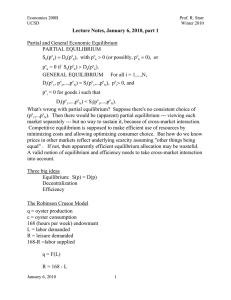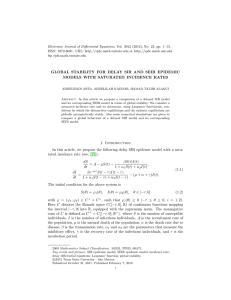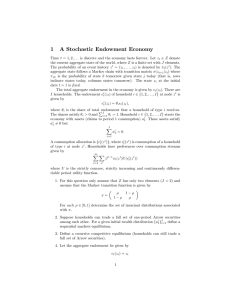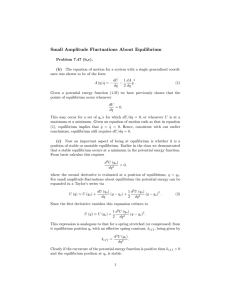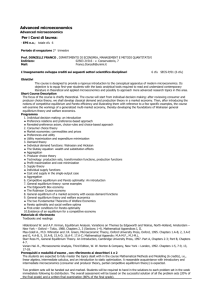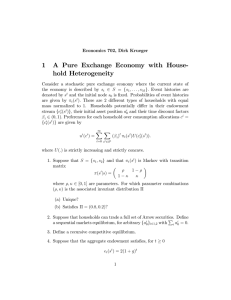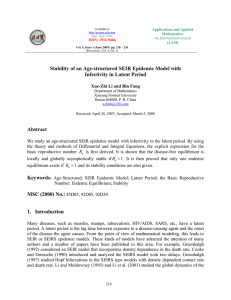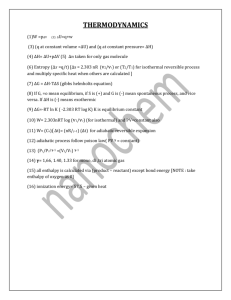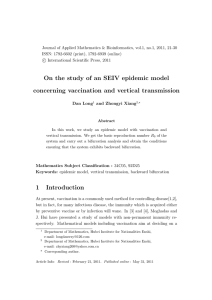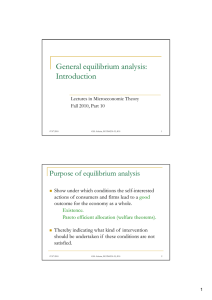Global Stability of Worms in Computer Network Bimal Kumar Mishra
advertisement
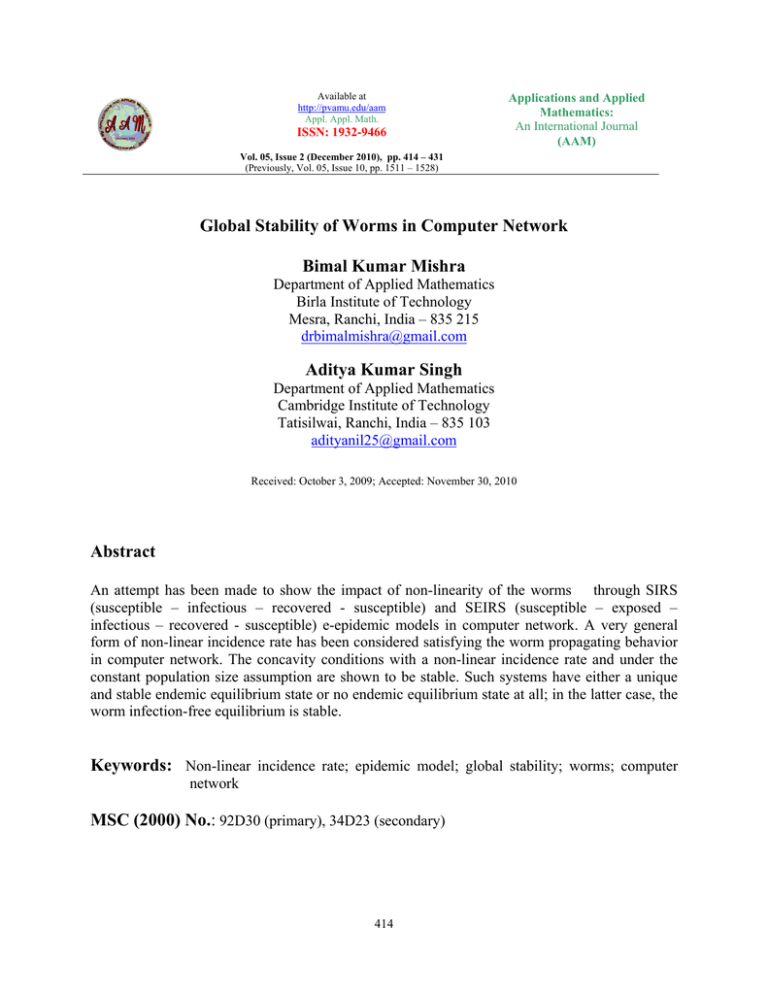
Available at http://pvamu.edu/aam Appl. Appl. Math. ISSN: 1932-9466 Applications and Applied Mathematics: An International Journal (AAM) Vol. 05, Issue 2 (December 2010), pp. 414 – 431 (Previously, Vol. 05, Issue 10, pp. 1511 – 1528) Global Stability of Worms in Computer Network Bimal Kumar Mishra Department of Applied Mathematics Birla Institute of Technology Mesra, Ranchi, India – 835 215 drbimalmishra@gmail.com Aditya Kumar Singh Department of Applied Mathematics Cambridge Institute of Technology Tatisilwai, Ranchi, India – 835 103 adityanil25@gmail.com Received: October 3, 2009; Accepted: November 30, 2010 Abstract An attempt has been made to show the impact of non-linearity of the worms through SIRS (susceptible – infectious – recovered - susceptible) and SEIRS (susceptible – exposed – infectious – recovered - susceptible) e-epidemic models in computer network. A very general form of non-linear incidence rate has been considered satisfying the worm propagating behavior in computer network. The concavity conditions with a non-linear incidence rate and under the constant population size assumption are shown to be stable. Such systems have either a unique and stable endemic equilibrium state or no endemic equilibrium state at all; in the latter case, the worm infection-free equilibrium is stable. Keywords: Non-linear incidence rate; epidemic model; global stability; worms; computer network MSC (2000) No.: 92D30 (primary), 34D23 (secondary) 414 AAM: Intern. J., Vol. 05, Issue 2 (December 2010) [Previously, Vol. 05, Issue 10, pp. 1511 – 1528] 415 1. Introduction The invention of computers, has drastically changed our society computer networking has revolutionized in the field of Education, Information, and Defense. But a few decades ago, cyber world is facing several challenges in the form of malicious agents like viruses, worms, Trojan horse etc. Initially in spite of a large number of viruses, an only minor damage to machinery was caused and their spread was very slow. In recent years, however, owing to the rapid development of technology malicious agents have become a major threat. They are capable of acquiring personal data of users, such as clients bank accounts, secret information of defense etc. With a view to protect our software and other valuable information, it is hence important to study about different malicious agents in the cyber space, their features , propagating methods and means and their limitation. To improve the safety and reliability in computer systems and networks, it is important to have the capacity to recognize and combat the several types of infections faster and more effectively. Epidemiological models with non-linear incidence rate have been studied by several authors [Hethcote (1989); Hethcote (2000); Hethcote, Van Den Driessche (1991); Derrick, Van Den Driessche (1993); Derrick, Van Den Driessche (2003)]. Briggs and Godfray (1995) considered different form of non-linear incidence rate for the study of infection of insects. Some work has been done by Korobeinikov [Korobeinikov et al. (2004); Korobeinikov, Maini (2004); Korobeinikov, Wake (2002)] for the Lyapunov function and global properties for SIRS and SEIRS epidemiological models with non-linear incidence. La Salle and Lefschetz (1961) used direct Lypunov method for stability. Liu et al. (1989) proposed dynamical behavior of epidemiological models with non-linear incidence rate. The action of malicious objects throughout a network can be studied by using epidemiological models for disease propagation [Mishra, Saini (2007); Mishra, Jha (2007); Mishra, Jha (2009); Keeling, Eames (2005); Williamson, Leill (2003); Madar, Kalisky et al(2004); Newman, Forrest et al(2002); Piqueira, Cesar (2008); Piquira, Monteiro (2005); Pastor-Satorra, Vespignani (2002); May, Lloyd (2001); Richard, Mark (2005); Datta, Wang (2005); Chen, Jamil (2006); Wang et al. (2003); Hua, Guoquing (2008)]. Several authors have studied on bilinear standard incidence rate, but these may require modification, for example the underlying assumption of homogeneous mixing may not be true in cyber world. In this case, the necessary population structure and heterogeneous mixing may be incorporated into a model with a specific form of non-linear transmission. In this work, we assume a general form f(S, I, N) as a non-linear incidence rate constrained with a few e-epidemic feasible conditions. We show that for SIR and SEIR models (a) if basic reproduction numbers, that is, R 1 then the endemic equilibrium of the system asymptotically stable, and (b) if 0 R 1, then there is no endemic equilibrium state, and the worm infection-free equilibrium state 0 is asymptotically stable. In the next stage we again show that for the instability of the endemic equilibrium state, the incidence rate of f(S, I, N) must be convex with respect to infection I. For global stability, we take incidence rate as a product of two function, i.e., f(S, I) = h(S).g(I) and then construct a Lyapunov function. 416 B.K. Mishra and A.K. Singh We consider a horizontally transmitted infection of worms (transmission from an infective host to a susceptible node) in computer network .We postulate that the incidence rate depends on the variables S, I, and N only and is given by a function f(S, I, N). The function f(S, I, N) must satisfy the conditions f(S, 0, N) = f (0, I, N) = 0 (1) and f ( S , I , N ) f ( S , I , N ) 0, 0 , for all S,I >0. I S (2) We also assume that the function f(S, I, N) is concave with respect to the variable I, that is, 2 f (S , I , N ) 0 for all S,I >0 . I 2 (3) In the cyber world it has been observed that, most e-epidemic non-linear incidence rates lead to a function concave with respect to the number of infective nodes I. Thus, the condition (3) may be a consequence of saturation effects: when the number of infective nodes is very high so that exposure to the worm agent is virtually certain, the incidence rate will respond more slowly than linearly to the increase in I. For a discrete-time model, a non-linear transmission function is concave with respect to the number of infective nodes. The same result, a concave incidence rate or a worm disease transmission function, can be obtained if a non-linear transmission function is introduced into a discrete-time model to capture non-homogeneity of the population structure. In this paper we show that autonomous compartmental e-epidemiological models with a non-linear incidence rate satisfying conditions (1) - (3) and under the constant population size assumption are stable. Such systems have either a unique and stable endemic equilibrium state or no endemic equilibrium state at all; in the latter case, the worm infection-free equilibrium is stable. In fact, the condition (3) is a sufficient condition for the system to be stable. 2. The e- SIRS Worm Propagation Model and Its Stability Based on our assumptions, we have the following dynamical system: dS N f (S , I , N ) S R , dt dI f (S , I , N ) I I ( ) , dt dR I R R , dt AAM: Intern. J., Vol. 05, Issue 2 (December 2010) [Previously, Vol. 05, Issue 10, pp. 1511 – 1528] 417 where is birth and natural death rate of nodes, is the death of the nodes due to attack of worms, is the loss of immunity rate, and is the rate of recovery of the nodes after the run of antivirus software. Further, we assume N S I R. Thus, the reduced system of equations takes the form . S N S I f S, I , N , . I f S, I , N I . (A) At equilibrium state, we have f S, I , N I , (4) N ( ) S ( ) I f (S , I , N ) . Thus, from equation (1), we have, N ( ) S ( ) I ( ) , (5) at worm infection free equilibrium state, Q0 ( S0 , I 0 ) , where S0 N and I 0 0 . Apart from the worm infection free equilibrium, Q0, the system can have positive endemic equilibrium states. If S and I are coordinates of an endemic equilibrium state Q , then we have the following lemma: Lemma 1. If the condition f(S, 0, N) = 0 = f (0, I, N) and S, I > 0; f ( S , I , N ) f ( S , I , N ) 0, 0 for all I S 2 f ( S , I , N ) 0 for all S, I>0 I 2 f S , I , N f S , I , N 2 f 0; 0, 2 0S , I 0, I S f then, at the endemic equilibrium state I (0, I ) f ( S , I , N ) , where the strict I 2 f (S , I , N ) 0 , for all I (0, I ) . equality hold only if 2 I Proof: 418 B.K. Mishra and A.K. Singh From equation (5) at endemic equilibrium state, f (S , I , N ) ( ) I . Let f ( I ) f ( S , I , N ) . Also assume that S, I , N I d f (I ) . dI (6) By the Mean Value Theorem (MVT), if I1 (0, I ) . Then, d f ( I1 ) f ( I ) f (0) f ( S , I , N ) f ( S , 0, N ) f ( S , I , N ) I ( ) . dI I I I I If I ( I , I ) , then again using the MVT, we have f S , I0 , N 2 I 2 d 2 f I0 dI 2 d f I d f I1 dI dI I I1 d f I = dI I I1 . We have already assumed that d f I dI and _ d f (I * ) ( ) 2 f (S * , I0 , N ) f * dI 0 0, I I1 I* I I 2 S which contradicts the hypothesis of the Lemma and, hence, S*, I *, N I . Furthermore, the strict equality all I 0, I * f S * , I * , N I holds only if 2 f (S , I , N ) 0 , for I 2 AAM: Intern. J., Vol. 05, Issue 2 (December 2010) [Previously, Vol. 05, Issue 10, pp. 1511 – 1528] 419 The expected number of secondary cases produced by one infective host in an entirely susceptible population is R0 1 f S0, I 0 , N I . (7) Theorem 1. (a) If the incidence rate f(S, I, N) satisfies the conditions (1), (2) and (3) and if R0 > 1, then the endemic equilibrium state Q Q , I * of the system (5) is asymptotically stable. (b) If R0 1 , then there is no endemic equilibrium state, and the worm infection – free equilibrium state is asymptotically stable. Proof (a): Jacobian of the system (A) is f ( S )(1) J f S Det J = f )(1) I , f I ( f f . I S From equation (2) and Lemma 1 we have f ( S , I , N ) f ( S , I , N ) f f 0; 0; 0. I S I I Therefore, we can write, Det J = f f f 0 . I S S Now the sum of upper triangular and lower triangular matrix, i.e., 1 2 = f f f , since . I I S 420 B.K. Mishra and A.K. Singh Therefore, 1 2 f f f f 0. I S S S Hence, the real parts of the eigenvalues are negative and the fixed point Q is asymptotically stable. Proof (b): At the worm infection-free equilibrium state, Q0 , from equation (2) and equation (7) we have f ( S0 , I 0 ) f ( ) R0 respectively. S0 , I 0 0 , and S I At this point the eigenvalues are 1 0, 2 f R0 . I Thus, 2 R0 1 , when R0 1 real parts of the eigen values are negative and the fixed point Q0 will be asymptotically stable. 3. The e- SEIRS Worm Propagation Model and Its Stability For this model we add a new Exposed group, E. Based on our assumptions we have the system of equations as: dS N f S, I , N S R , dt dE f S, I , N E E , dt dI E I I , dt dR I R R , dt where is the rate of transfer of nodes from E to I – class. Since N S E I R , R may be removed and, thus, we have the reduced system as (B) AAM: Intern. J., Vol. 05, Issue 2 (December 2010) [Previously, Vol. 05, Issue 10, pp. 1511 – 1528] dS N S I E f S , I , N , dt dE f S , I , N E , dt dI E I I . dt 421 (8) We also assume that f(S, 0, N) = 0 = f (0, I, N) (9) and f S , I , N f S , I , N 0; 0 for all S, I > 0. I S We also assume that the function f(S, I, N) is concave w.r.t. the variable I, i.e., 2 f S, I , N 0, I 2 for all S, I >0. We define the basic reproduction number of the system as R0 f S0 , I 0 , N . I Equilibrium states of the system satisfy dS dI dE 0; 0; 0. dt dt dt We have, f S , I , N E and E I . Thus, f S, I , N I . Now, E I . N S Thus, f S , I , N I and E ( ) I . We have f(S, 0, N) = 0, the worm infection – free equilibrium state, Q0 , is (N, 0, 0). 422 B.K. Mishra and A.K. Singh Lemma 2: If f(S, 0, N) = f (0, I, N) = 0 and S, I , N f S , I , N 0; 0 , for all S, I >0 I S 2 f S, I , N 0, for all S, I > 0 and if Q S , E , I * is the endemic equilibrium state, 2 I then f S , I , N I The strict equality holds only if . 2 f S, I , N 0, I 0, I , S S I 2 Theorem 2. (a) If the incidence rate f(S, I, N) satisfies the conditions f(S, 0, N) = 0 = f(0, I, N); f S , I , N f S , I , N 2 f S, I , N 0, for all S, I > 0 and R0 0, then the 0, 0, I 2 I S endemic equilibrium state, Q , of the system (B) is asymptotically stable. (b) If R0 1, then there is no endemic equilibrium state, and the worm infection free equilibrium is asymptotically stable. Proof: The Jacobian of the system (B) is f f 1 1 S I f f J= 1 . S I 1 0 By the Routh-Hurwitz Criterion, the eigenvalues of the matrix have negative real parts if and only if the inequalities a1 , a2 , a3 0 and 2 a1a2 a3 0 hold for the coefficient of the characteristic equation 3 a1 2 a2 a3 0 . Characteristic equation of the above matrix AAM: Intern. J., Vol. 05, Issue 2 (December 2010) [Previously, Vol. 05, Issue 10, pp. 1511 – 1528] ( J I = f ) S f S 0 1 f I f I f f 2 2 I S f f f f . S S I S The above characteristic will be identical with 3 a1 2 a2 a3 0 . f Coefficient of 2 , i.e., a1 S f 3 >0 . = S Coefficient of f 2 S f f 2 2 0 I S = a2 2 and f f f a3 S I S f f f f > 0 . S S I S For 2 , we obtain f f 2 ) ( ) 2 ( ) 2 ( 2 ) S S f f ( )( 2 )a1 ( 2 )( ) 2 - S S 2 a1a2 a3 = a2 ( 423 424 B.K. Mishra and A.K. Singh ( 2 )( ) ( ) 2 ( )( ) f 0 . S Therefore, all three roots of the characteristic equation have negative real parts, and, hence, the endemic equilibrium state, Q , is asymptotically stable. Proof (b): At the worm infection-free equilibrium, Q0 , a1 3 , a2 2 (1 R0 ) , a3 1 R0 , 2 a2 2 2 . 2 Therefore, R0 < 1 ensures the infection-free equilibrium is asymptotically stable. 4. Global Properties of SIR and SEIR System The majority of the incidence rates can be represented as a product of two functions f(S, I) = h(S)g(I), where h depends only on S and g depends only on I. For the incidence rate of the form 2 h(S)g(I) satisfying the condition h(0)g(I) = 0 = h(S)g(0) and h S g I 0 , for all S , I > I 2 0 , direct Lyapunov method enables us to prove global stability for some models. To construct the Lyapunov function, we require an auxiliary function with specific properties. To construct Lyapunov function for SIR and SEIR with incidence rate of the form h(S)g(I) ,we take N = 1, i.e., S, E, I and R are the fractions of the susceptibles, the exposed, the infectives and the recovered in the population and S+E+I+R = 1 hold. THE SIR MODEL dS h S g I S , dt dI h( S ) g ( I ) I ( ) . dt The SEIR Model is dS h S g I S , dt (10) AAM: Intern. J., Vol. 05, Issue 2 (December 2010) [Previously, Vol. 05, Issue 10, pp. 1511 – 1528] 425 dE h S g I E , dt dI E I . dt (11) We assume that the incidence rate satisfies the conditions h(0)g(I) = 0 = h(S)g(0), (12) h S g I h S g I 0; 0, S I (13) and 2h S g I 0 , for all S, I > 0. 2 I (14) The condition (14) ensures that each of these systems has two equilibrium states; an worm infection – free equilibrium, Q0 , i.e., S0 1 as E0 I 0 0 , and from system (11) E I , E h S g I , E , I B hS g I , where B , for SEIR model and B =1 for the SIR model. For endemic equilibrium state , Q S , E , I , such that B I S , B I S , B I h S g I . For SIR and SEIR models, we construct a Lyapunov function of the form I d d V S , E, I S h S B I g I c E E log E . h g a 0 S Here, c = 1, for SEIR model and c = 0, for the SIR model. 426 B.K. Mishra and A.K. Singh The endemic equilibrium state, Q , is the only extremum and global minimum of the function. The function V(S, E, I) satisfies g I h S V E V V , 1 c 1 B 1 ; ; S h S E E I g I and it is easy to see that Q is a stationary point of the function. Since the function h(S) and g(I) V V grow monotonically, the partial derivatives and grow monotonically as well., Hence, S I Q is the only extremum of the function. Therefore ' 2V h S h S 0, 2 S 2 . h S 2V E c 0 E 2 E2 g I g' I 2V and B 0, 2 I 2 g I whereas, 2V 2V 2V 0. S E S I EI The point Q is the minimum. The point Q is the only internal stationary point of the function it is minimum and V(S, E, I) tends to infinity at the boundary. Q is the global minimum, the function is bounded below . Hence, the function V(S, E, I) is a Lyapanov function. The following theorem provides global properties of the system (10) and (11) . Theorem 3. (i) If the incidence rate satisfies the condition h(0)g(I) = 0 = h(S)g(0) and 2h S g I 0 , for all S, I > 0 and if R0 1 , then the endemic equilibrium state, Q , is I 2 globally asymptotically stable. (ii) If R0 1 , then there is no positive equilibrium Q and the worm infection –free equilibrium state, Q0 , is globally asymptotically stable. Proof: In the case of the SEIR system (11) using h S g I B I ; S B I ; E B I . AAM: Intern. J., Vol. 05, Issue 2 (December 2010) [Previously, Vol. 05, Issue 10, pp. 1511 – 1528] 427 For the equilibrium state Q , the Lyapunov function V(S, E, I) satisfies dV S , E , I V dS V dE V dI dt S dt E dt I dt hS E h S g I S 1 = 1 h S g I E hS E g I E I B 1 g I h S g I S hS hS hS hS g I S h S E h S g I E E g I g I + B E I E I g I g I + h S g I E h S h S g I E g I E S hS S hS B I 2 S 1 S h S h S g I E g I E hS S hS g I I I g I B I g I I I g I h S h S g I E g I E S hS 3 S 1 1 B I h S h S g I E g I E hS S g I g I I + B I 1 . g I g I I (15) dV 0 , for all S, E, I > 0. Equality hold only at the point dt Q . Since the arithmetic mean is greater than or equal to geometric mean, The concavity of the g(I) ensures that hS hS h S g I E hS g I E g I E g I E 3 , for all S, E, I > 0. 428 B.K. Mishra and A.K. Singh Since for a monotonically growing function h(S), h(S) h S , when S S and h S h S , when S S . Therefore, S hS 0; S 0 , 1 1 hS S if g I g I g I I I ; for all 0 < I I ; and I g I I for I I . Therefore, g I g I I 1 0; g I g I I From equation (15), dV 0. dt By the asymptotic stability theorem, the SEIR system is globally asymptotically stable. To prove global stability of the infection – free equilibrium states Q0 , we consider the Lyapunov function of the form S U S , E , I S h S0 a Here, c = 1 and B d cE BI . h for the SEIR model and c = 0 and B = 1 for the SIR model. In the case of SEIR System, the Lyapunov satisfies dU S , E , I U dS U dE U dI . dt S dt E dt I dt Here, h S0 U U U 1 c; B. ; S I h S E AAM: Intern. J., Vol. 05, Issue 2 (December 2010) [Previously, Vol. 05, Issue 10, pp. 1511 – 1528] 429 Therefore, dU h S0 dS dE dI 1 c B. dt h S dt dt dt Thus, dU h S0 1 h S g I S c h S g I E B E dt h S h S0 h S0 hS g I S h S0 g I S h S g I E hS hS + E I B ; where B and c =1 h S0 g I h S0 1 1 S B I hS B I h S0 h S0 g I 1 S 1 1 . B I h S B I 1 S h S0 Here, 1 S 1 0 , for all S >0 . h S From the conditions f(S, 0, N) = f (0, I, N) = 0 and 2 f S, I , N 0; S , I 0 , we have I 2 h S0 g I h S0 g 0 R0 . I B I B Therefore, R0 1 , then dV 0 , for all S, E, I > 0 and, hence, Q0 is globally asymptotically dt stable. 5. Conclusion Compartmental e-epidemic SIRS and SEIRS models have been developed to show the impact of non-linearity of the worms in computer network. Keeping in mind the propagating behavior of worms and its self replication characteristics in computer networks, a very general form of nonlinear incidence rate has been considered. The concavity conditions with a non-linear incidence rate and under the constant population size assumption are shown to be stable. We had shown that, if R0 1 , then there is no positive endemic equilibrium Q and the worm infection –free 430 B.K. Mishra and A.K. Singh equilibrium state Q0 is globally asymptotically stable. Such systems have either a unique and stable endemic equilibrium state or no endemic equilibrium state at all; in the latter case, the worm infection-free equilibrium is stable. REFERENCES Mishra, Bimal Kumar, Saini, D.K. (2007). SEIRS epidemic model with delay for transmission of malicious objects in computer network, Applied Mathematics and Computation, 188, 14761482. Mishra, Bimal Kumar, Saini, D.K. (2007). Mathematical models on computer viruses, Applied Mathematics and Computation, 187, 929-936. Mishra, Bimal Kumar, Jha, Navnit (2007). Fixed period of temporary immunity after run of antimalicious object software on computer nodes, Applied Mathematics and Computation 190,1207-1212. Mishra, Bimal Kumar, Jha, Navnit (2010). SEIQRS model for the transmission of malicious objects in computer network, Applied Mathematical Modelling, 34(3), March 2010, 710715. Briggs, C. J. & Godfray, H. C. J. (1995). The dynamics of insect–pathogen interactions in stagestructured populations, Am. Nat., 145, 855–887. Chen, T., Jamil, N. (June 2006). Effectiveness of quarantine in worm epidemics, In IEEE International Conference on Communications 2006, IEEE, 2142–2147. Datta, S., Wang, May. H. (2005). The effectiveness of vaccinations on the spread of email-borne computer viruses, In IEEE CCECE/CCGEI, IEEE, 219–223. Derrick, W. R. & Van Den Diressche, P. (1993). A disease transmission model in a non constant population, J. Math. Biol., 31, 495–512. Derrick, W. R. & Van Den Driessche, P. (2003). Homoclinic orbits in a disease transmission model with nonlinear incidence and nonconstant population, Discrete Contin. Dyn. Syst. Ser. B, 3, 299–309. Derrick, W. R. & Van Den Driessche, P. (2003). Homoclinic orbits in a disease transmission model with nonlinear incidence and nonconstant population, Discrete Contin. Dyn. Syst. Ser. B, 3, 299–309. Derrick, W. R. & Van Den Driessche, P. (1993). A disease transmission model in a nonconstant population, J. Math. Biol., 31, 495–512. Hethcote, H. W. & Van Den Driessche, P. (1991). Some epidemiological models with nonlinear incidence, J. Math. Biol., 29, 271–287. Hethcote, H. W. (2000).The mathematics of infectious diseases, SIAM Rev., 42, 599–653. Hethcote, H.W., Lewis, M. A. & Van Den Driessche, P. (1989). An epidemiological model with delay and a nonlinear incidence rate, J. Math. Biol., 27, 49–64. Keeling, M.J., Eames, K.T.D. (2005). Networks and epidemic models, Journal of the Royal Society Interface, 2 (4), 295–307 Korobeinikov, A. & Maini, P. K. (2004). A Lyapunov function and global properties for SIR and SEIR epidemiological models with nonlinear incidence, Math. Biosci. Eng., 1, 57–60. Korobeinikov, A. & Wake, G. C. (2002). Lyapunov functions and global stability for SIR, SIRS and SIS epidemiological models, Appl. Math. Lett., 15, 955–961. AAM: Intern. J., Vol. 05, Issue 2 (December 2010) [Previously, Vol. 05, Issue 10, pp. 1511 – 1528] 431 Korobeinikov, A. (2004). Lyapunov functions and global properties for SEIR and SEIS epidemic models, IMAMath. Med. Biol., 21, 75–83. La Salle, J. & Lefschetz, S. (1961). Stability by Liapunov’s direct method, New York: Academic Press. Liu, W. M., Hethcote, H. W. & Levin, S. A. (1987). Dynamical behavior of epidemiological models with nonlinear incidence rates, J. Math. Biol., 25, 359–380. Madar, N.T., Kalisky, R., Cohen, D., Avraham, Ben, Havlin, S. (2004). Immunization and epidemic dynamics in complex networks, European Physical Journal B, 38, 269–276. May, R.M., Lloyd, A.L. (2001). Infection dynamics on scale-free networks, Physical Review E, 64 (066112), 1–3. Newman MEJ, Forrest S, Balthrop J. (2002). “Email networks and the spread of computer viruses, Physical Review E, 66:035101-1–035101-4. Pastor-Satorras, R., Vespignani, A. (2002). Epidemics and immunization in scale-free networks, Handbook of Graphs and Networks: From the Genome to the Internet, Wiley-VCH, Berlin Piqueira JRC, Cesar F.B. (2008). Dynamical models for computer viruses propagation, Mathematical Problems in Engineering, doi: 10.1155/2008/940526. Piqueira, JRC, Navarro, BF, Monteiro, LHA. (2005). Epidemiological models applied to viruses in computer networks, Journal of Computer Science, 1(1), 31-4. Richard, W. T., Mark, J. C. (2005). Modeling virus propagation in peer-to-peer networks, In IEEE International Conference on Information, Communications and Signal Processing (ICICS 2005), 981-985. Wang, Y., Wang, C. X. (October 2003). Modeling the effects of timing parameters on virus propagation, In 2003 ACM Workshop on Rapid Malcode, ACM, 61–66. Williamson, Ma. M., Leill, J. (2003). An epidemiological model of virus spread and cleanup, http://www.hpl.hp.com/techreports/ Yuan, Hua., Chen, Guoqing (2008). Network virus-epidemic model with the point-to-group information propagation, Applied Mathematics and Computation, 206, 357–367. Biographical Sketch Bimal Kumar Mishra is an Associate Professor in the Department of Applied Mathematics, Birla Institute of Technology, Mesra, Ranchi, India – 835215. He received his Master’s degree in Operational Research from University of Delhi, Delhi and Masters in Mathematics also. He earned his Ph. D. degree from Vinoba Bhave University, Hazaribag, Jharkhand, India and D.Sc. degree from Berhampur University, Berhampur, Orissa, India. His research area is in the field of population dynamics and flow of blood in human body. He is presently working in the area of Mathematical models and Simulation on Cyber attack and Defense. Aditya Kumar Singh is a faculty member in the Department of Applied Mathematics, Cambridge Institute of Technology, Tatisilwai, Ranchi, India – 835 103. He received his Master degree in Mathematics from University of Delhi, Delhi. Since 2008, he has been working towards the Ph. D. degree in Birla Institute of Technology, Mesra, Ranchi, India. His research interests include Modeling and Simulation on cyber attack and defense.
